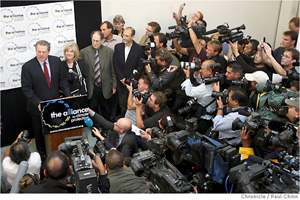 |
Click
on a Topic Below |
| Home » Science as a Contact Sport » Press & Reviews |
|
|
ORDER
NOW! |
|
| Science as a Contact Sport: Inside the Battle to Save the Earth's Climate |
Click here for Stephen Schneider's New Republic interview with Marilyn Berlin Snell, Q&A: Dr. Stephen Schneider, One of the world's leading climatologists discusses the line between science and activism. Click here for National Geographic Newswatch editor, David Braun's comments and interview with Stephen Schneider about "Science as a Contact Sport: Inside the Battle to Save the Earth's Climate". Click here to download Steve Schneider’s Q&A with National Geographic Books for the media. From the National Geographic Society Press Release: WASHINGTON (Oct. 6, 2009)—As world attention turns to COP15, the United Nations Climate Change Conference in Copenhagen from Dec. 7 to 18, the latest book by pioneering climate scientist Stephen Schneider could not be more timely. In SCIENCE AS A CONTACT SPORT...Schneider reveals the dramatic story behind the headlines on global warming as he chronicles nearly four decades of procrastination and politics since scientists first alerted world leaders to the dangers of climate change. Schneider, along with his colleagues on the Intergovernmental Panel on Climate Change (IPCC) and Al Gore, won the 2007 Nobel Peace Prize for their efforts to enlighten the public about human-induced climate change and to inspire action to confront it. Schneider also was recently appointed a National Geographic Fellow.
For nearly 40 years, climate scientists have offered suggestions to governments around the globe on how to deal with climate risks. So why has it taken so long for the world to agree on what action is needed to combat the biggest threat facing mankind? The answers are both simple and complicated, and Schneider addresses the primary ones in this blockbuster scientific “tell-all.” Schneider has seen more of the politics and science of climate change than almost anyone else, and his passion for the science has inspired many to join the campaign to address climate change. As Tim Flannery, author of “The Weather Makers” and chairman of the Copenhagen Climate Council, writes in the foreword, “He’s been so effective at countering the climate skeptics and lobbyists that he’s become a special target of their campaign to discredit leading scientists.” Writing from his own personal experience “in the trenches of the climate wars since 1970,” Schneider provides a blow-by-blow account of the infighting and backroom negotiations that have brought us to the brink of disaster. He reveals the invisible history of the decades-long struggle to bring global warming to the world’s attention, detailing the courage of some and the ignorance and duplicity of others that have inhibited the world community from implementing solutions sooner. Now we find ourselves with lost decades and with most of the early, dire predictions happening at an accelerated rate: sea levels rising; glaciers melting; unprecedented heat waves and wildfires; intensification of hurricanes as they move over warmed oceans; and arctic sea ice rapidly thinning all year long and increasingly disappearing in summer. Further delay may result in irreversible conditions, including melted ice sheets, redrawn coastlines and species driven to extinction. As dire as the forecast is, however, Schneider does not engage in handwringing. He offers a realistic but hopeful prescription for how we — both governments and individuals — can take steps toward positive action. For governments, that means creating energy-efficiency standards for buildings and machines; investing in clean technology research; cap and trade or carbon taxes; geoengineering schemes to try to remove CO2 from the air and help prevent some of the large impacts of climate change; and smart growth planning. Individuals can do their part by avoiding unnecessary automobile use; conserving energy at home; buying energy-efficient cars and appliances; eating more local foodstuffs and less imported foods; showing up at city council meetings to advocate for a greener town; and supporting local politicians who stand up for sustainability. “But most important for me,” he writes, “as grandparent, parent and teacher, is to hum in your head often the lines of the Crosby, Stills & Nash song: ‘Teach your children well.’”
|
